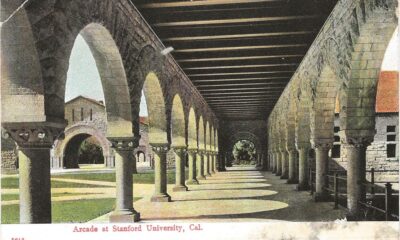Creation Corner
How creationism didn’t teach someone real science

On October 27, 2017, one Tony Reed published a YouTube video in his long-running series. He calls it “How Creationism taught me real science.” The specific video he uploaded carried the subtitle “Episode 61: Hydroplate Theory.”
Mr. Reed lays out several specific problems he says he has with the Hydroplate Theory. Sadly for him, those problems seem to be problems of his own making. Your editor recently prepared a transcript of this video. He did it the old-fashioned way: listen, type, listen, type, like a secretary-transcriptionist working with a Dictaphone®.
Before describing the problems with the Reed video, CNAV presents a “streaming movie” by Bryan Nickel of Real Science Radio. This two-hour-and-forty-one-minute feature presents the Hydroplate Theory best of all, aside from reading the book. Walt Brown will personally vouch for it.
Problems with Reed’s presentation
CNAV will here apply the kindness and charity the civil law requires. After all, one cannot prove fraud with motive alone. That aside, Mr. Reed’s problems with the Hydroplate Theory are actually problems of one of the following types:
- Reading comprehension. Tony Reed gives every indication of having read Walter T. Brown’s book In the Beginning: Compelling Evidence for Creation and the Flood cursorily at best. He makes several claims about the initial conditions Brown assumes, and predictions Brown makes. Those claims are at direct variance with the written text. A more intense read would have prevented these problems.
- Scholarly research. Mr. Reed cites several sources. Of necessity he does not “bookmark” his video with citations. Instead he lists them all as endnote equivalents in his Video Description. The problem: he is not as careful as he should be in determining what the source says, and how the source made any given determination. Your editor discussed one such point already.
- Knowledge of the laws of physics. He makes one error that might seem arcane, but turns out to be highly salient. Beyond that he conflates Dr. Brown’s actual claims with currently accepted wisdom. Which wisdom Brown has exposed repeatedly as folly.
Herewith a review of the entire twenty-minute video, with excerpts from the transcript. First, take time to play the video to verify the transcript for yourselves. Watching, listening, and reading are believing.
How creationism didn’t teach Tony Reed to read?
We can dispense with the introductory words; they present no problem that doesn’t repeat itself. Here, however, is the first problem:
t = 2:42
The Hydroplate Theory is presented in the second section, titled “Fountains of the Great Deep.” In Brown’s scenario, the continental plates, comprised mostly of granite, were once just a single uniformly thick layer of granite encircling the entire planet. In earlier incarnations of the theory, Brown estimated the thickness of the granite plates to be around 10 miles thick. However he has subsequently revised his figure on his Web site to be anywhere from twenty to sixty miles. I would expect the upcoming ninth edition to reflect this as well.
Beneath these granite plates would have been a vast underground cavern of water containing roughly half the water currently in our oceans today, and also encircling the planet. Beneath this cavern of water was also a layer of basalt encircling the globe to a depth of up to 100 miles. Below this basalt is a layer of heated, but solid, mantle, leading downward into a liquid outer core and a solid inner core. The granite layer was held fast to the basalt layer by millions of pillar-like structures where the surface warped downward. Due to this warping, the surface at the time had some relief, including various small mountains and shallow depressions, allowing for shallow seas—but nothing as dramatic as the planet’s modern-day topography.
Stop the tape!1
Walt Brown, in a conversation with this reviewer, never intended to imply that the Earth’s crust was solid granite, through and through. And he certainly never said a layer of basalt, an igneous rock, lay at the floor of the subcrustal chamber.
More to the point, the above gets the description of the Earth’s core completely wrong. The Earth’s core did not become part solid, part molten, until the Flood event. Before the Flood, you had nothing but crust, then the subcrustal ocean,then a solid, cool core.
Reed here assumes that present conditions2 for the interior of the Earth were identical to the initial conditions before the Flood.
Roll tape
t = 3:48
Although Brown claims that there are no miracles required, there is no current explanation for how water could ever have become trapped between discreet layers of granite and basalt.
Brown correctly notes that granite has never been replicated in a lab. The distinguishing characteristic of all granites is their granular appearance. This is the result of materials like quartz and feldspar within magma forming crystals over the course of cooling.3 Geologists have known for centuries how to grow crystals in the lab. And in fact you can purchase lab-grown crystals, including quartz and feldspar, on-line, at any gem show, or even at your local jeweler. If you’re so inclined, you can also purchase science kits that allow you to grow your own at home.
The process of growing crystals is a relatively simple one. Place a small sample of crystal in an aqueous solution of dissolved crystalline materials, and then simply wait–and you’ll see that the dissolved crystalline materials in the aqueous solution have accumulated and grown in a crystalline pattern. You can do a faster version of this process using Epsom salts, which dissolve and accumulate rather rapidly. Within hours you will have a noticeably larger crystal, or even several crystals. The same applies to dissolved crystals like quartz or feldspar, with the notable exception that they require much higher temperatures, like that of magma, to dissolve.
Describing mantle
The magma in the mantle is often described as solid. But this is only half correct. The temperatures in the mantle are hot enough to make solid rock pliable. In this state it is commonly referred to as a solid. But it also has the characteristic known as visco-elasticity. In this state, crystalline material does float throughout the rock, but nowhere near as rapidly as in water.4
For this reason, the observed process of crystallization requires significantly longer periods of time. If the magma cools quickly, the crystals don’t have time to form. The result is a rock like diurite, which has the same chemical composition as granite, but with a more diffuse concentration. Due to the immense heat, when magma is collected in the field, it is immediately cooled in water, impeding the crystallization process. Regardless, due to the size of crystals in granite or diurite, geologists can determine when and where in the earth’s surface the rock initially formed. [Cue graphic saying the failure to replicate granite in a laboratory is irrelevant.]
Stop the tape!
Herewith the second problem. Reed conflates creation with the Flood. Walt Brown never said the initial conditions didn’t require a miracle. He said the Flood Event did not require one. Once the conditions were in place, the rest was inevitable. This will come up later, but this answer to the question “What triggered the Flood?” gives an excellent overview of the initial conditions of the Earth as Brown envisions them.
In general, Brown applies a rule that CNAV calls “Brown’s Razor.” According to it, one does not invoke miracles without direct Scriptural attestation of same. Genesis chapter 1 attests to a series of miracles for the creation of the universe, the Earth, and life. Genesis chapters 7 and 8 do not necessarily attest to miracles for the Flood. Those chapters attest to the direct observations of their authors, namely Shem, Ham and Japheth, the sons of Noah.
Roll tape
t = 5:50
According to the theory, the water trapped between the granite and basalt layer was being circulated by a process known as tidal pumping, due to the Moon’s gravity and orbit around the planet. This motion, as well as centrifugal force due to the Earth’s rotation and the minor gravitational effects of the Sun, caused the planet to slightly bulge along its equator, increasing friction in the waters, resulting in their significant increase in temperature over time. Being trapped between the two rock layers, the increase in water temperature led to an increase in pressure.
This continued until the temperature was so hot, and the pressure was so high, that the water became supercritical. A fluid is supercritical when it exists in a superheated and super-pressurized state where it is too hot to remain liquid and yet too pressurized to remain a gas. At this point the two states of matter are indistinguishable.5
Stretching of the “granite plate”
The concept of tidal pumping, in and of itself, makes some sense. I won’t bother to contest the temperatures and pressures involved. But there are some issues with the overall scenario. As Brown points out, when pressures build beneath, the granite plate would be stretched and become thinner. A very similar concept can be observed by stretching a rubber band. As it becomes more and more stretched, the thinner it becomes. As the pillar-like structures are part of the granite plate, they should be stretched and become thinner, too, pulling away from the basalt layer.
Compounding this is the elongation of the Earth’s diameter at the equator, due to the Earth’s rotation. The difference is merely twenty miles. This also stretches the pillar-like structures. And since a majority of the plate is not attached to the planet, there is far less resistance keeping it attached. This stretches the plate and the pillar-like structures even further. In this model, Brown significantly overestimates the elasticity of granite.6,7
Stop the tape!
Reed’s persistent error of assuming that Brown postulates a uniform granite crust affects nearly every subsequent thing he says. The above text typifies this error.
Reed does correctly identify the key condition of the subcrustal ocean: supercritical water. The key consequence of supercritical water, which Reed does not mention, is its capacity as a solvent. The Black and White Smokers of the Mid-Atlantic Ridge are plumes of escaping supercritical water. These hold solutes, like tar, that would never dissolve in ordinary water.
Roll tape
t = 7:26
Disregarding this, as the tidal pumping of supercritical water continued, the pillar-like structures began to weaken, until at least one pillar crumpled, and a fissure opened up in the granite, going downward into the water beneath. A modern example used to support the Hydroplate Theory is the surface of Europa, a moon around Jupiter. On January 6, 2014, and again in February of 2016, NASA witnessed what appeared to be plumes of water erupting from the surface of Europa.8 Similar phenomena have been observed on Saturn’s moons, as well.9 These eruptions might seem like an analogue for the Hydroplate Theory. But they are in fact plumes of water bursting through frozen water, not plates of granite. Additionally the plumes themselves are singular, individual ice volcanoes caused by immense forces resulting from being tidally locked with Jupiter. This example fails as an example for the Hydroplate model.
But assuming the initial condition of the granite plate presented by the Hydroplate Theory is correct, it would seem inevitable that a rupture would occur. Many creationist organizations, such as Answers in Genesis,10 Creation Ministries International,11 and the Creation Research Society,12 have asserted that this scenario presents a ticking time bomb, implying that the destruction of the world was inevitable from the beginning. Which further implies that God intended to destroy the world from the beginning.
This really has no bearing on the theory. But it may be notable that Brown rejects these assertions out of hand.
Stop the tape!
Walt Brown does not necessarily reject the specific assertion that the Flood was a cataclysm waiting to happen. Read again his answer to the question, “What triggered the Flood?”
The creation was “very good.” Sometime after the Fall but before the flood, a chain of physical events began that produced a global flood. The earth then was filled with violence (Genesis 6:11), so humans may have been directly responsible, although we cannot be sure exactly how it began.
The sheer violence of the Flood event precludes our setting a limit on the technological level of antediluvian civilization. (Exception: antediluvian civilization likely did not have nuclear fission or fusion.) That civilization left no ruins, because three miles of rock, sand and mud buried it all.
But while that civilization probably did not have nuclear demolition charges, they likely had high-explosive demolition charges. Suppose, then, that someone detonated such a charge at an unfortunate spot on or near the surface. Suppose the shock wave traveled down to a pillar—and cracked it. That would put the crust under stress, and lead to the rupture.
The miracle here, is that God gave Noah 120 years’ advance warning of the disaster. In addition, God gave Noah the best and most vital ship design in the history of naval architecture. The first major ship any humans built is still the best.
Preliminary conclusion: creationism still survives
In eight minutes and forty-five seconds of footage, Tony Reed tries to test the Hydroplate Theory. But he tests only his own embarrassment. CNAV notes thus far that he only half read Walt Brown’s book. His sources only partly support his thesis thus far and cannot compensate for his errors in reading comprehension.
In further installments of this series, CNAV will explore other, more damaging errors of logic and comprehension the Reed video makes. Creationism obviously did not teach him “real science,” unless “real science” consists of rejecting creation a priori. And a priori acceptance or rejection is never scientific.
Endnotes
1 This and subsequent uses of the expressions “Stop the tape” and “Roll tape” appear here with apologies to Graham Ledger. Mr. Ledger created and hosts The Daily Ledger, weeknights at 8:00 p.m. ET on the One America News Network.
2 Robinson EC, “The Interior of the Earth,” United States Geological Survey. <https://pubs.usgs.gov/gip/interior/>
3 Definition of granite at a classroom-aid site at the University of California at Berkeley. <https://nature.berkeley.edu/classes/eps2/wisc/granite.html>
4 For the apparent supporting citation, see Sawyer EW, “Formation and Evolution of Granite Magmas During Crustal Reworking: the Significance of Diatexites”, Journal of Petrology, 39(6):1147-1167, 1 June 1998. <https://doi.org/10.1093/petroj/39.6.1147>
5 Galli G and Pan D, “A closer look at supercritical water,” Proceedings of the National Academy of Science, 110(16):6250-6251, 16 April 2013. <https://doi.org/10.1073/pnas.1303740110>
6 See Saadati M, Forquin P, Weddfelt K, and Larson PL, “On the Tensile Strength of Granite at High Strain Rates considering the Influence from Preexisting Cracks”, Advances in Materials Science and Engineering, 2016:Art. 6279571, 14 June 2016 <http://dx.doi.org/10.1155/2016/6279571>
Endnotes (continued)
7 Stowe RL, “Strength and deformation properties of granite, basalt, limestone, and tuff at various loading rates,” Defense Atomic Suport Agency, 25 March 1969. <https://apps.dtic.mil/dtic/tr/fulltext/u2/684358.pdf>
8 “NASA’s Hubble Spots Possible Water Plumes Erupting on Jupiter’s Moon Europa.” Press Release 16-096, 26 September 2016. <https://www.nasa.gov/press-release/nasa-s-hubble-spots-possible-water-plumes-erupting-on-jupiters-moon-europa>
9 The most prominent of these is Enceladus, as the controllers of the Cassini-Huygens mission observed to their delight.
10 Reed here cites a reference, not from AiG, but from Glenn R. Morton at Old Earth Ministries in 2003. <http://www.oldearth.org/walter_brown_hydroplate_theory.htm> Answers in Genesis does not have any response to any part of the Hydroplate Theory, with one exception. Danny R. Faulkner disputes the validity of the Brown and Hurlbut astronomical fix for the date of the Global Flood. <https://answersingenesis.org/the-flood/can-one-astronomically-date-the-flood-within-the-hydroplate-model/>
11 Oard MJ, “Analysis of Walt Brown’s Flood Model,” Creation Ministries International, 7 April 2013. <https://creation.com/hydroplate-theory>
12 The hyperlink Reed gives for the CRS response yields HTTP Error 404: Page Not Found. Neither does the Web Archive (“Wayback Machine”) have an archive of that page.
Terry A. Hurlbut has been a student of politics, philosophy, and science for more than 35 years. He is a graduate of Yale College and has served as a physician-level laboratory administrator in a 250-bed community hospital. He also is a serious student of the Bible, is conversant in its two primary original languages, and has followed the creation-science movement closely since 1993.
-

 Civilization3 days ago
Civilization3 days agoDC Pipe Bomb Arrest Raises Questions About Christopher’s Wray’s FBI
-

 Civilization4 days ago
Civilization4 days agoThe Legal Logic Behind U.S. Operations Against Narco-Terrorist Networks
-

 Guest Columns5 days ago
Guest Columns5 days agoCongressional Leaders See Far Higher Stock Returns Than Peers
-

 Executive4 days ago
Executive4 days agoNewsom’s ‘National Model’ for Homeless Wracked by Fraud
-

 Executive3 days ago
Executive3 days agoWhen You’re in a Hole, Stop Digging
-

 Education3 days ago
Education3 days agoWaste of the Day: Taxpayers Subsidize Football Coach Severance
-

 Executive2 days ago
Executive2 days agoWaste of the Day: Obamacare Failed Test, Approved Fraudulent Subsidies
-

 Executive3 days ago
Executive3 days agoWaste of the Day: Feds Pay Nonprofits That Sue the Government













[…] (22 January 2019), after CNAV published the first installment in the Tony Reed v. Creationism series, it received a call from Walter T. Brown. Brown has a simple […]
[…] might benefit from reading Parts One and Two of this […]